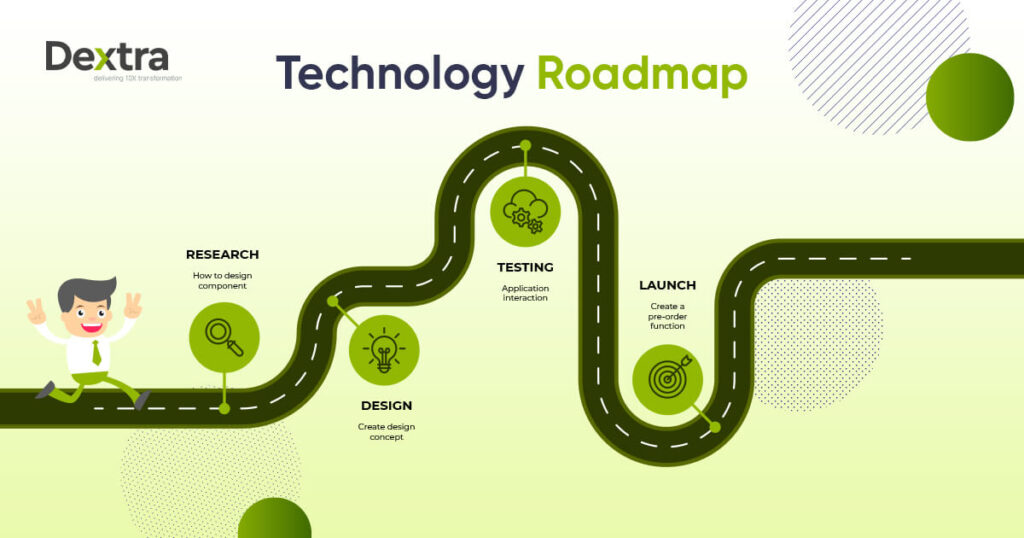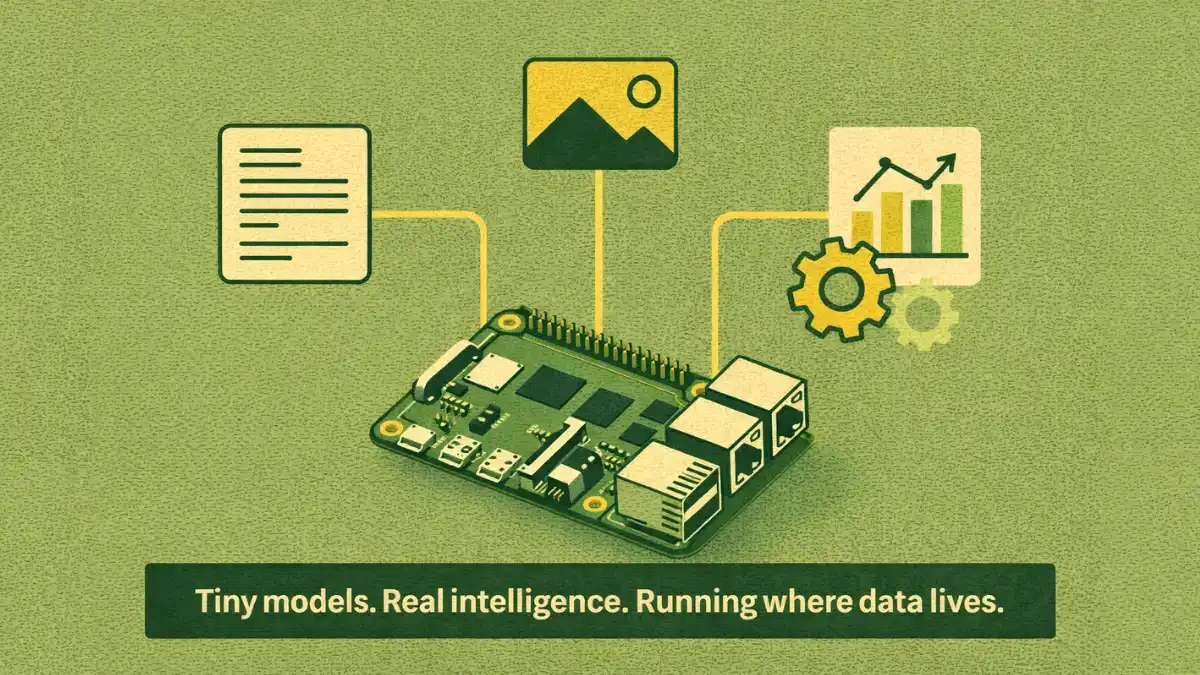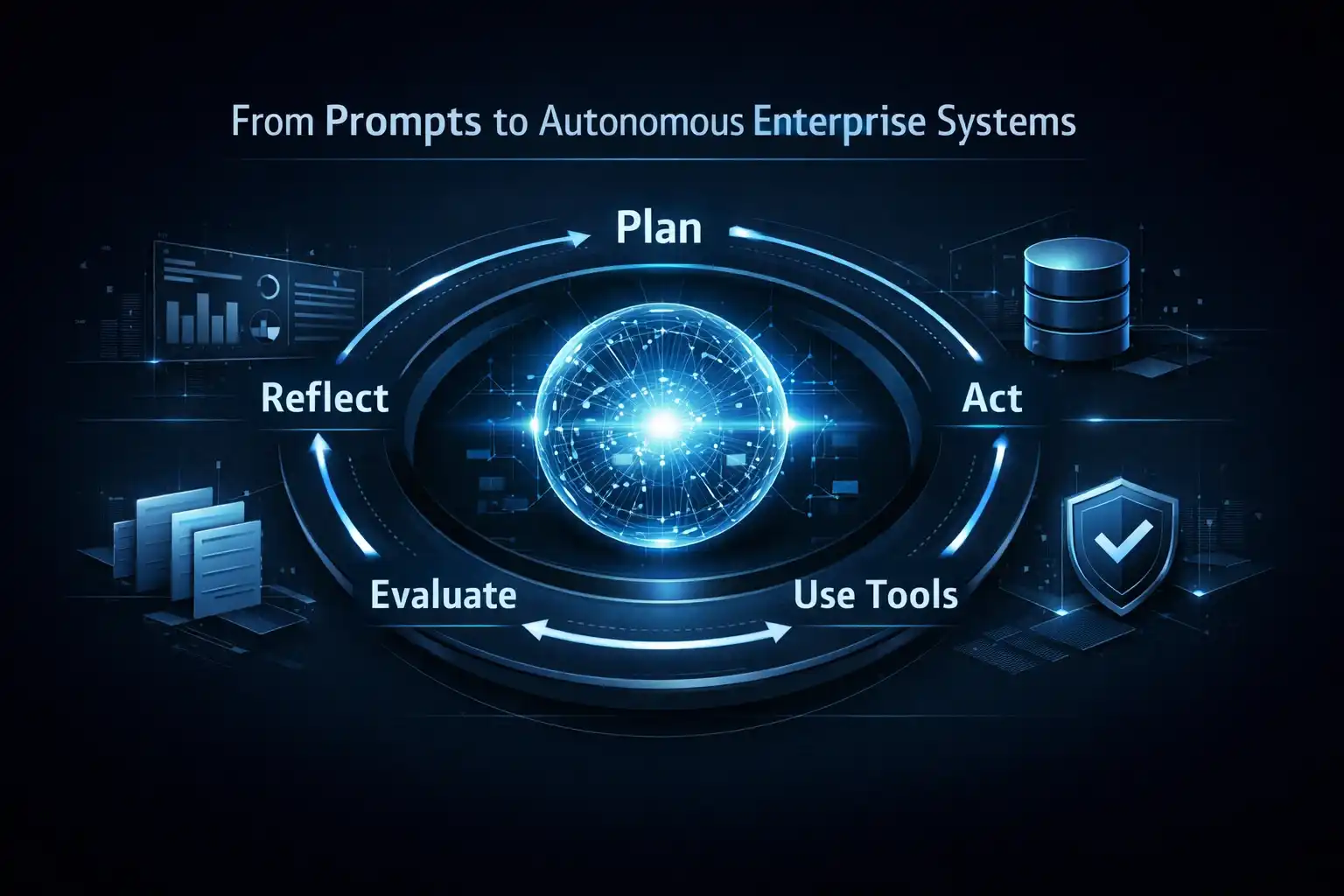A technology roadmap is more than a planning document, it is a strategic blueprint that defines how an organization uses technology to achieve long-term business objectives. It connects vision with execution, helping teams decide not only what to build, but when and why each technology investment matters.
In an environment where technologies evolve faster than business cycles, organizations without a clear roadmap often struggle with fragmented systems, misaligned priorities, and costly course corrections. A well-structured technology roadmap provides clarity by outlining the initiatives, dependencies, and milestones required to move from today’s capabilities to tomorrow’s goals.
For enterprises, growing startups, and investment-driven organizations alike, technology roadmaps play a critical role in ensuring that resources are allocated wisely, risks are identified early, and technology decisions remain aligned with business strategy. This guide explores what a technology roadmap is, its essential elements, the different types used across industries, and the tangible benefits it delivers when executed effectively.
What Is a Technology Roadmap?
A tech roadmap is a thorough strategic plan that helps a business create and deploy technological solutions to fulfill its long-term objectives. It gives a clear structure for identifying and connecting important technologies with the company’s business goals. This roadmap shows the steps for upgrading existing systems and combining technology to improve efficiency and productivity.
A technological roadmap also defines milestones and priorities, which assist businesses in managing resources and remaining competitive. This encourages collaboration across departments, ensuring that all teams work toward the same technology goals.
In practice, many enterprises struggle not with defining a roadmap, but with validating whether their technology choices are viable, scalable, and aligned with real business outcomes. This is where experienced AI consulting and technical due diligence consultant add value. Dextralabs help organizations assess architecture readiness, data maturity, and long-term feasibility before major investments are made.
10 Important Elements of a Technology Roadmap
A technology roadmap comprises several important components that influence the organization’s technological strategy. Here are its key components:
1) Business Objectives
Business objectives are the goals that your firm hopes to achieve through its technology investments. These objectives make your roadmap and ensure that each technological work contributes to overall business growth.
2) Technical Vision
This is the long-term vision for how technology will progress within the organization. It creates the strategic direction for technology adoption and innovation and outlines the organization’s desired technological capabilities. The vision guides all technology efforts toward a future state that supports the company’s objectives.
For enterprises, SMEs, and fast-scaling technology startups, a strong technical vision increasingly includes AI-first architectures—such as LLM-powered workflows, retrieval-augmented generation (RAG), and agent-based systems. Defining this vision often requires external expertise to evaluate data readiness, security constraints, and integration complexity across regions like the USA, UK, UAE, India, and Singapore.
3) Current Technology Assessment
A comprehensive assessment of your current IT environment is important for identifying strengths and gaps. This assessment helps you determine what tools and infrastructure are already in place and how well they fulfill current business requirements. It also lays the groundwork for finalizing which technologies to upgrade or preserve.
4) Key Initiatives and Projects
These are the specific technology projects and activities that will be implemented to meet business objectives. Each project should have clear objectives and a deadline. This feature facilitates the organized implementation of technology solutions focusing on high-priority sectors.
5) Timelines & Milestones
Timelines and milestones define when each initiative or project will be implemented. They set critical timelines for technology adoption and system changes. Milestones are essential for tracking progress and making sure that the company stays on track.
6) Resource Allocation
Resource allocation decides the budget, staff, and tools required for the technology strategy. It makes sure that the organization has the resources to finish each project successfully. Proper allocation also helps avoid resource limits that could ruin the plan.
7) Dependencies and Risks
A technological roadmap should identify project dependencies and potential dangers to its success. Dependencies can be technical or organizational, such as waiting for one system to be upgraded before implementing another. On the other hand, Identifying risks early helps the company plan for opportunities and avoid disruptions.
8) Scalability and Flexibility Plans
Scalability helps ensure that the technology selected can expand and adapt as the company grows. Flexibility refers to the roadmap’s capacity to respond to changes in the business environment or technological advancements. These factors ensure the roadmap is relevant and future-proof so businesses can pivot as needed.
9) Metrics For Success
It is important to create clear success criteria to measure the technological plan’s performance. These measurements can be key performance indicators (KPIs) such as cost savings, process, or customer satisfaction. Regularly monitoring these indicators ensures that the roadmap is reaching its objectives.
10) Stakeholder Alignment
The success of a technological roadmap depends on the alignment of stakeholders. This component involves key decision-makers and technical teams so everyone is on board with the roadmap’s goals. Clear communication and alignment promote teamwork and efficient execution.
Types of Technology Roadmaps
There are many types of technology roadmaps, such as:
1) Product Roadmap
A product roadmap tracks the development and expansion of a single product. It describes the features and technologies that will be implemented over time. This roadmap keeps teams on track with customer needs and corporate objectives to keep the product competitive and relevant.
2) Tech Roadmap for Infrastructure
The Technology Roadmap for Infrastructure focuses on a company’s technical infrastructure, including hardware and software systems. It describes how to improve or replace these components to better support company operations. Companies with a clear plan can avoid downtime and make strategic IT investments.
3) Innovation Roadmap
An innovation roadmap helps guide the implementation of new technology and innovative solutions. It focuses on finding and implementing innovations that boost efficiency and customer satisfaction. This type of road map is important for businesses trying to keep ahead of industry developments and preserve a competitive advantage.
4) Platform Roadmap
A platform roadmap outlines the creation and evolution of a technology platform that supports several products or services. It highlights goals to combine new technologies and scale the platform to meet user demand. With a clear platform roadmap, businesses be at peace that their basic technology base is secure and capable of sustaining long-term growth.
5) Service Roadmap
A service roadmap focuses on improving and developing customer and internal services. It outlines the technologies and systems needed to provide better service experiences through automation or faster response times. This roadmap is important for ensuring that services align with customer expectations and corporate objectives, which results in increased satisfaction and efficiency.
6) Strategic IT Roadmap
Strategic IT roadmaps combine the company’s IT strategy with business goals. They describe the IT efforts and projects that will be adopted to promote growth and digital transformation. By prioritizing IT initiatives and setting clear goals, companies can optimize their technology investments and build a strong IT framework.
10 Major Benefits of a Technology Roadmap:
Here’s how a technology roadmap can be a lifesaver with numerous benefits for you:
1) Aligns Technology With Business Goals
A technology roadmap helps ensure that all technology investments and choices are directly related to the overall company plan. It explains how different technologies will help businesses reach their goals, such as improving efficiency or growing operations.
2) Improves Resource Allocation
With a defined technology roadmap, businesses can better deploy resources such as time and manpower. It checks which technologies or systems should be prioritized and helps companies direct their resources where they will have the greatest impact. This leads to more efficient expenditure and guarantees that teams work on initiatives with the highest return on investment.
3) Improves Collaboration Among Teams
A roadmap encourages collaboration by clearly showing the technical route ahead. It promotes collaboration among divisions on similar goals, including IT and product development. This cross-functional collaboration results in improved communication and more consistent implementation of IT initiatives.
4) Reduces Risk and Uncertainty
A technological roadmap decreases the risk of implementing new technologies by providing specific processes and dates. It helps organizations to anticipate obstacles and manage change more successfully. This proactive strategy prevents costly mistakes and facilitates smoother transitions during technological rollouts.
5) Promotes Future-Proofing and Innovation
A technological roadmap helps businesses remain ahead of the curve by anticipating future demands and developing trends. It makes sure that organizations invest in current technology and plan for future developments such as AI or cloud computing. This forward-thinking approach helps companies remain competitive and adaptive in a fast-changing technological context.
6) Improves Decision-Making
A technological roadmap can help make more informed and structured decisions. The roadmap creates a clear context for exploring new technological options and understanding how they fit into the larger picture. As a result, leadership teams can base their judgments on long-term objectives rather than short-term solutions.
7) Improves Efficiency and Productivity
A roadmap simplifies operations and improves operational efficiency by planning technological upgrades and integrations ahead of time. It helps teams embrace technology in a coordinated manner, limits interruptions and maximizes the benefits of new tools.
This increases productivity throughout the organization since employees can perform more effectively when the correct technology is in place.
8) Ensures Scalability
A well-structured technology roadmap considers the company’s future growth and technology requirements. It envisions scalable solutions that can expand with the business, which ends the need for usual rework or costly changes. This assures that the IT infrastructure can handle greater demand and larger operations over time.
How to Create the Perfect Technology Roadmap?
Here are some helpful suggestions for creating a successful technological roadmap:
1) Create Clear Business Goals
Before developing a technological roadmap, it is important to understand your organization’s overarching business objectives. Check your company’s major goals, such as increasing efficiency or improving client experiences. Align your technology strategy with these objectives to guarantee that each attempt promotes long-term success
2) Engage Key Stakeholders
Include all key stakeholders, such as leadership and technical teams, in the roadmap formulation process. Each department can have distinct requirements and viewpoints on how technology could support its work. Engaging stakeholders ensures that the roadmap reflects a company-wide strategy and that all teams are aligned with technological objectives.
3) Evaluate Current Technology
Conduct a comprehensive assessment of your present IT infrastructure and processes. Find out what works and where gaps exist. This assessment will assist you in knowing which technologies to maintain or replace as part of your plan, which will result in more efficient resource utilization.
4) Prioritize Initiatives
Not all technology efforts can be executed simultaneously. Prioritize initiatives according to their potential impact and alignment with corporate objectives. Concentrate on high-priority efforts that provide the most value while developing a clear plan for addressing lower-priority chores over time.
5) Set Realistic Timelines
When creating your roadmap, set specific timelines for each phase of implementation. Be realistic about project timelines and take the budget and resources into account. Setting realistic deadlines will help to manage expectations and keep the project on track.
6) Stay Flexible and Adaptable
Technology is continuously growing, so your plan should be adaptable to new advances. Be willing to check and revise your plan as needed, particularly if new possibilities or obstacles develop. This agility ensures your plan is relevant and effective in a rapidly changing environment.
7) Check Metrics for Success
Create key performance indicators (KPIs) to assess the effectiveness of each technology attempt. These indicators will allow you to monitor development and determine whether the technology provides the intended value. Regularly identifying these KPIs helps your strategy achieve its objectives and positively influences the organization.
8) Consider Scalability
When developing your technology roadmap, consider how implementing these technologies will scale with your business. Choose solutions that can develop and change with your firm and avoid expensive repairs later. It will help you know that the technology will evolve along with the company, which will prevent costly system changes or replacements in the future.
9) Plan for Risks and Contingencies
No plan is without risks, so it’s important to know potential issues early on. Consider budget limits and technology shortcomings. Preparing measures for these risks will help you manage unseen setbacks without ruining your goal.
10) Communicate the Roadmap Clearly
Once your roadmap has been defined, make it apparent to all stakeholders. You need to be sure that everyone understands the goals and priorities and their roles in carrying out the plan. Clear communication encourages commitment and helps in the successful implementation of the roadmap.
11) Strategic IT Roadmap
In investment-led environments, such as private equity acquisitions or strategic mergers, the strategic IT roadmap becomes a critical decision-making artifact. It is often reviewed alongside technical due diligence findings to assess whether the target company’s technology stack can scale post-acquisition or support long-term value creation.
Why Technology Roadmaps Fail Without Independent Evaluation?
Even well-documented technology roadmaps can fail if critical assumptions go unchecked. Overestimated AI capabilities, under-scoped infrastructure costs, or misaligned vendor decisions often surface only after capital has already been deployed.
This is why investors, boards, and executive teams increasingly rely on independent technical due diligence alongside roadmap planning. A neutral assessment helps validate whether a roadmap is execution-ready, especially during M&A, fundraising, or large-scale digital transformation initiatives.
Firms like Dextra Labs support VCs, private equity firms, and corporate M&A teams by evaluating AI systems, data pipelines, cloud architectures, and engineering maturity. It help decision-makers reduce risk before committing capital.
Conclusion
Whether you are an enterprise modernizing legacy systems, a startup designing an AI-first roadmap, or an investor evaluating technology risk, the value of a technology roadmap lies in both its vision and its validation. Combining structured roadmap planning with expert AI consulting and technical due diligence ensures that technology decisions are not only ambitious but executable. A technology roadmap is useful for helping companies plan and implement technology solutions that align with their business objectives. It outlines a clear strategy for implementing new technology and remaining competitive in a rapidly changing environment. Companies can use a roadmap to increase efficiency and guarantee that their technology investments align with their long-term goals.
FAQs:
Q. Is Tech Roadmap the Same Thing as a Strategy?
A strategy focuses on the “what” and “why,” whereas a roadmap focuses on the “how” and “when” of executing the strategy.
Q. Who Is Responsible for the Technology Roadmap?
The product manager is accountable for the product roadmap. As a result, the PM will drive the roadmap planning process.
Q. What Is a Good Roadmap?
A good roadmap conveys the correct information to the appropriate audience in a visually appealing manner.








